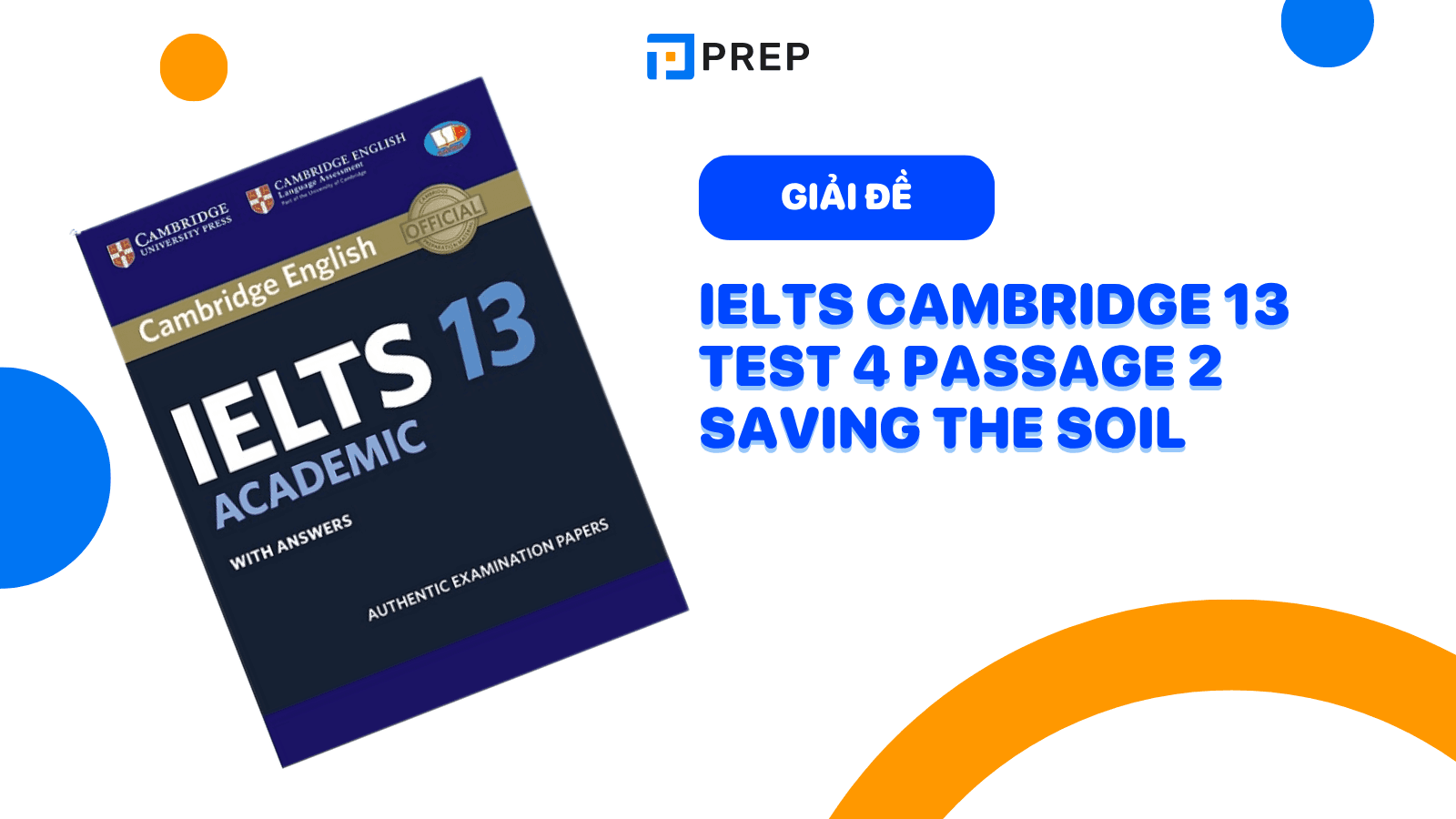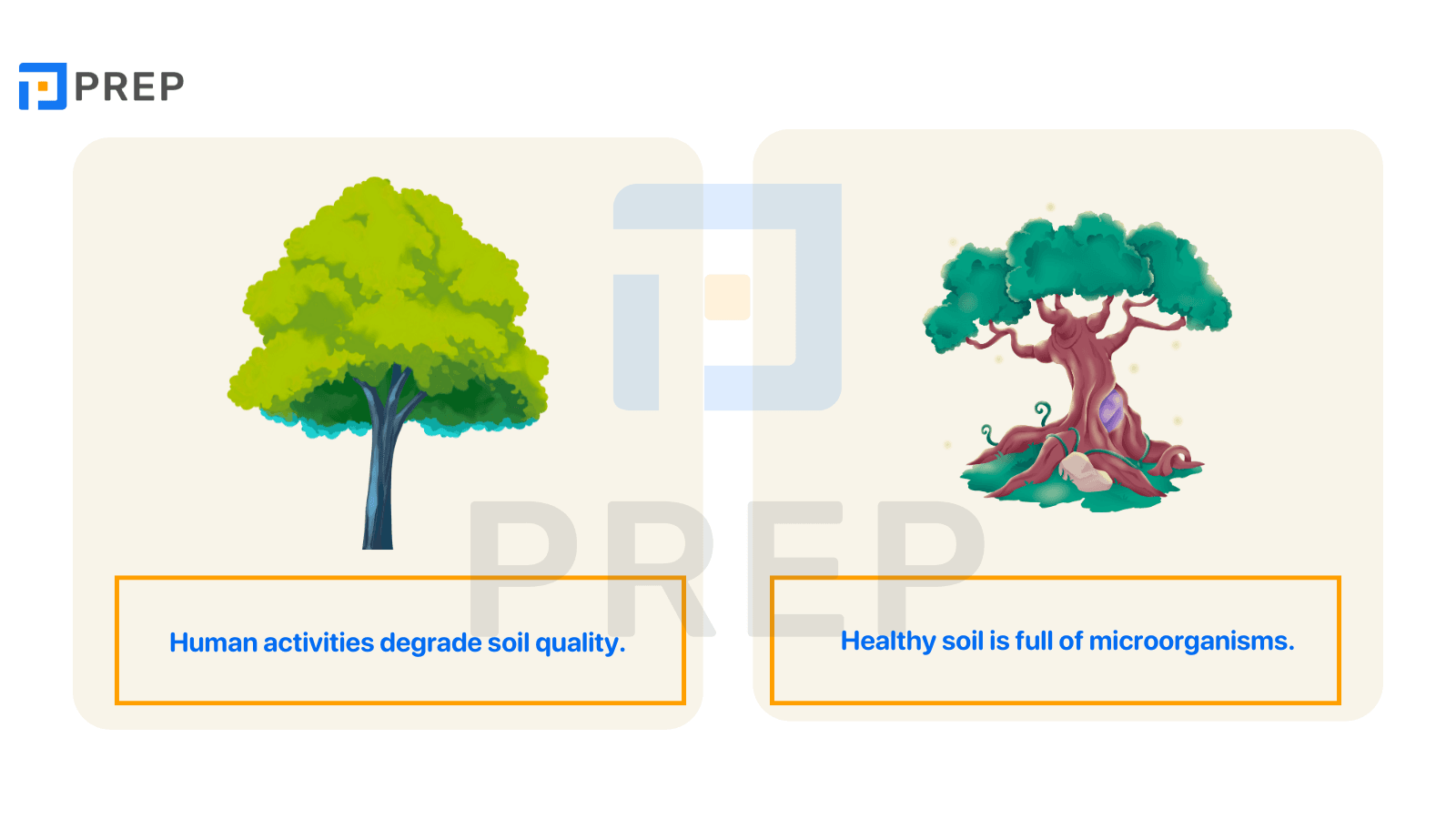Đề bài và đáp án bài đọc IELTS Cambridge 13 Test 4 Passage 2 Saving the soil
Bài đọc Saving the Soil trong IELTS Cambridge 13 Test 4 Passage 2 bàn về vấn đề suy thoái đất trên thế giới và các giải pháp nhằm bảo vệ nguồn đất yếu tố mang tính sống còn cho nông nghiệp và hệ sinh thái. Passage cung cấp số liệu, dẫn chứng khoa học cùng quan điểm của các chuyên gia môi trường, yêu cầu thí sinh vận dụng kỹ năng đọc hiểu chi tiết, suy luận và nhận dạng cấu trúc lập luận. Bài viết dưới đây là đề bài, đáp án chuẩn kèm giải thích chi tiết từng câu hỏi, từ vựng học thuật quan trọng giúp bạn cải thiện kỹ năng đọc học thuật và chinh phục band điểm cao trong IELTS Reading.

I. Đề bài IELTS Cambridge 13 Test 4 Passage 2 Saving the soil
Reading Saving the soil
SAVING THE SOIL
More than a third of the Earth’s top layer is at risk. Is there hope for our planet’s most precious resource?
A. More than a third of the world’s soil is endangered, according to a recent UN report. If we don’t slow the decline, all farmable soil could be gone in 60 years. Since soil grows 95% of our food, and sustains human life in other more surprising ways, that is a huge problem.
B. Peter Groffman, from the Cary Institute of Ecosystem Studies in New York, points out that soil scientists have been warning about the degradation of the world’s soil for decades. At the same time, our understanding of its importance to humans has grown. A single gram of healthy soil might contain 100 million bacteria, as well as other microorganisms such as viruses and fungi, living amid decomposing plants and various minerals.
That means soils do not just grow our food, but are the source of nearly all our existing antibiotics, and could be our best hope in the fight against antibiotic-resistant bacteria. Soil is also an ally against climate change: as microorganisms within soil digest dead animals and plants, they lock in their carbon content, holding three times the amount of carbon as does the entire atmosphere. Soils also store water, preventing flood damage: in the UK, damage to buildings, roads and bridges from floods caused by soil degradation costs £233 million every year.
C. If the soil loses its ability to perform these functions, the human race could be in big trouble. The danger is not that the soil will disappear completely, but that the microorganisms that give it its special properties will be lost. And once this has happened, it may take the soil thousands of years to recover.
Agriculture is by far the biggest problem. In the wild, when plants grow they remove nutrients from the soil, but then when the plants die and decay these nutrients are returned directly to the soil. Humans tend not to return unused parts of harvested crops directly to the soil to enrich it, meaning that the soil gradually becomes less fertile. In the past we developed strategies to get around the problem, such as regularly varying the types of crops grown, or leaving fields uncultivated for a season.
D. But these practices became inconvenient as populations grew and agriculture had to be run on more commercial lines. A solution came in the early 20th century with the Haber-Bosch process for manufacturing ammonium nitrate. Farmers have been putting this synthetic fertiliser on their fields ever since.
But over the past few decades, it has become clear this wasn't such a bright idea. Chemical fertilisers can release polluting nitrous oxide into the atmosphere and excess is often washed away with the rain, releasing nitrogen into rivers. More recently, we have found that indiscriminate use of fertilisers hurts the soil itself, turning it acidic and salty, and degrading the soil they are supposed to nourish.
E. One of the people looking for a solution to this problem is Pius Floris, who started out running a tree-care business in the Netherlands, and now advises some of the world's top soil scientists. He came to realise that the best way to ensure his trees flourished was to take care of the soil, and has developed a cocktail of beneficial bacteria, fungi and humus* to do this. Researchers at the University of Valladolid in Spain recently used this cocktail on soils destroyed by years of fertiliser overuse. When they applied Floris's mix to the desert-like test plots, a good crop of plants emerged that were not just healthy at the surface, but had roots strong enough to pierce dirt as hard as rock. The few plants that grew in the control plots, fed with traditional fertilisers, were small and weak.
F. However, measures like this are not enough to solve the global soil degradation problem. To assess our options on a global scale we first need an accurate picture of what types of soil are out there, and the problems they face. That's not easy. For one thing, there is no agreed international system for classifying soil. In an attempt to unify the different approaches, the UN has created the Global Soil Map project. Researchers from nine countries are working together to create a map linked to a database that can be fed measurements from field surveys, drone surveys, satellite imagery, lab analyses and so on to provide real-time data on the state of the soil. Within the next four years, they aim to have mapped soils worldwide to a depth of 100 metres, with the results freely accessible to all.
G. But this is only a first step. We need ways of presenting the problem that bring it home to governments and the wider public, says Pamela Chasek at the International Institute for Sustainable Development, in Winnipeg, Canada. 'Most scientists don't speak language that policy-makers can understand, and vice versa.' Chasek and her colleagues have proposed a goal of 'zero net land degradation'. Like the idea of carbon neutrality, it is an easily understood target that can help shape expectations and encourage action.
For soils on the brink, that may be too late. Several researchers are agitating for the immediate creation of protected zones for endangered soils. One difficulty here is defining what these areas should conserve: areas where the greatest soil diversity is present? Or areas of unspoilt soils that could act as a future benchmark of quality?
Whatever we do, if we want our soils to survive, we need to take action now.
Questions 14-17
Complete the summary below.
Write ONE WORD ONLY from the passage for each answer.
Write your answers in boxes 14-17 on your answer sheet.
Why soil degradation could be a disaster for humans
Healthy soil contains a large variety of bacteria and other microorganisms, as well as plant remains and 14 __________. It provides us with food and also with antibiotics, and its function in storing 15 __________ has a significant effect on the climate. In addition, it prevents damage to property and infrastructure because it holds 16 __________.
If these microorganisms are lost, soil may lose its special properties. The main factor contributing to soil degradation is the 17 __________ carried out by humans.
Questions 18-21
Complete each sentence with the correct ending, A-F, below.
Write the correct letter, A-F, in boxes 18-21 on your answer sheet.
-
Nutrients contained in the unused parts of harvested crops
-
Synthetic fertilisers produced with the Haber-Bosch process
-
Addition of a mixture developed by Pius Floris to the soil
-
The idea of zero net soil degradation
A may improve the number and quality of plants growing there.
B may contain data from up to nine countries.
C may not be put back into the soil.
D may help governments to be more aware of soil-related issues.
E may cause damage to different aspects of the environment.
F may be better for use at a global level.
Questions 22-26
Reading Passage 2 has seven paragraphs, A-G.
Which section contains the following information?
Write the correct letter, A-G, in boxes 22-26 on your answer sheet.
NB You may use any letter more than once.
-
A reference to one person's motivation for a soil-improvement project
-
An explanation of how soil stayed healthy before the development of farming
-
Examples of different ways of collecting information on soil degradation
-
A suggestion for a way of keeping some types of soil safe in the near future
-
A reason why it is difficult to provide an overview of soil degradation

II. Đáp án IELTS Cambridge 13 Test 4 Passage 2 Saving the soil
Reading Passage 2, Questions 14-26
-
minerals
-
carbon
-
water
-
agriculture
-
C
-
E
-
A
-
D
-
E
-
C
-
F
-
G
-
F
III. Giải thích đáp án chi tiết IELTS Cambridge 13 Test 4 Passage 2 Saving the soil
Tham khảo phần giải thích đáp án chi tiết dưới đây để nắm rõ cách giải quyết từng câu hỏi nhé!
Questions 14–17 (Summary Completion)
|
Câu |
Đáp án |
Giải thích |
|
14 |
minerals |
Đoạn B: “...microorganisms… living amid decomposing plants and various minerals.” → soil contains bacteria, microorganisms, plant remains & minerals. |
|
15 |
carbon |
Đoạn B: soil locks in carbon, affecting climate change. |
|
16 |
water |
Đoạn B: soils store water, preventing flood damage. |
|
17 |
agriculture |
Đoạn C: “Agriculture is by far the biggest problem” → main cause of soil degradation. |
Questions 18–21 (Matching endings)
|
Câu |
Đáp án |
Giải thích |
|
18 |
C |
“unused parts of harvested crops” → humans don’t return nutrients back to soil (đoạn C). |
|
19 |
E |
Synthetic fertilisers → pollution, soil acidity, salinity (đoạn D). |
|
20 |
A |
Floris’ mixture improved plant growth & roots (đoạn E). |
|
21 |
D |
“zero net land degradation” helps governments understand the problem (đoạn G). |
Questions 22–26 (Matching Information)
|
Câu |
Đáp án |
Giải thích |
|
22 |
E |
Motivation of Pius Floris to improve soil (đoạn E). |
|
23 |
C |
Soil stayed healthy naturally — nutrients recycled in wild (đoạn C). |
|
24 |
F |
Soil data collected via surveys, satellites, lab tests (đoạn F). |
|
25 |
G |
Proposal to protect endangered soils (đoạn G). |
|
26 |
F |
Difficulty classifying soil globally; no unified system (đoạn F). |
IV. Từ vựng hay trong bài cần ghi nhớ
Take note nhanh một số từ vựng hay trong bài dưới đây để mở rộng vốn từ của bạn nhé!
|
Từ vựng |
Nghĩa |
Ví dụ |
|
degrade /dɪˈɡreɪd/ |
làm suy thoái |
Human activities degrade soil quality. (Hoạt động của con người làm suy thoái đất.) |
|
microorganism /ˌmaɪkrəʊˈɔːrɡənɪzəm/ |
vi sinh vật |
Healthy soil is full of microorganisms. (Đất khỏe chứa đầy vi sinh vật.) |
|
antibiotic-resistant /ˌæntibaɪˈɒtɪk rɪˈzɪstənt/ |
kháng kháng sinh |
Soil may help fight antibiotic-resistant bacteria. (Đất có thể giúp chống vi khuẩn kháng kháng sinh.) |
|
synthetic /sɪnˈθetɪk/ |
tổng hợp |
Farmers used synthetic fertilisers. (Nông dân dùng phân bón tổng hợp.) |
|
fertiliser /ˈfɜːrtəlaɪzər/ |
phân bón |
Excess fertiliser harms soil. (Dùng quá nhiều phân bón làm hại đất.) |
|
acidic /əˈsɪdɪk/ |
có tính axit |
The soil became acidic. (Đất trở nên có tính axit.) |
|
salty /ˈsɔːlti/ |
mặn |
Overuse of fertiliser makes soil salty. (Dùng phân bón quá mức làm đất bị mặn.) |
|
nutrient /ˈnuːtriənt/ |
chất dinh dưỡng |
Soil provides nutrients for plants. (Đất cung cấp dưỡng chất cho cây.) |
|
biodiversity /ˌbaɪəʊdaɪˈvɜːsəti/ |
đa dạng sinh học |
Soil loss affects biodiversity. (Mất đất ảnh hưởng đến đa dạng sinh học.) |
|
benchmark /ˈbentʃmɑːrk/ |
tiêu chuẩn so sánh |
Unspoilt soils act as benchmarks. (Đất nguyên sơ làm tiêu chuẩn đánh giá.) |

Trên đây là đề bài và đáp án kèm giải thích chi tiết bài đọc IELTS Cambridge 13 Test 4 Passage 2 Saving the soil. Hy vọng tài liệu trên sẽ hữu ích cho bạn trong quá trình luyện thi IELTS.
Học tiếng Anh online dễ dàng hơn với PREP - Nền tảng Học & Luyện thi thông minh cùng AI. Nhờ công nghệ AI độc quyền, bạn có thể tự học trực tuyến ngay tại nhà, chinh phục lộ trình học IELTS, TOEIC, tiếng Anh giao tiếp hiệu quả. Bên cạnh đó, học viên còn có sự hỗ trợ tuyệt vời từ Teacher Bee AI, trợ lý ảo giúp bạn giải đáp thắc mắc và đồng hành 1-1 trong suốt quá trình học tập. Hãy click TẠI ĐÂY hoặc liên hệ HOTLINE 0931428899 để nhận tư vấn chi tiết về các khóa học tiếng Anh chất lượng nhất thị trường!
Tải ngay app PREP để bắt đầu hành trình học tiếng Anh tại nhà với chương trình học luyện thi online chất lượng cao.

Chào bạn! Mình là Hiền Hoàng, hiện đang đảm nhận vai trò quản trị nội dung sản phẩm tại Blog của website prepedu.com.
Với hơn 5 năm tự học các ngoại ngữ như tiếng Anh, tiếng Trung và ôn luyện một số kỳ thi IELTS, TOEIC, HSK, mình đã tự đúc rút được nhiều kinh nghiệm để hỗ trợ hàng nghìn người đang gặp khó khăn trong việc học ngoại ngữ. Hy vọng rằng những chia sẻ phía trên sẽ giúp ích cho bạn trong quá trình tự ôn luyện thi hiệu quả tại nhà!
Bình luận
Nội dung premium
Xem tất cảLộ trình cá nhân hoá
Có thể bạn quan tâm
Kết nối với Prep

MSDN: 0109817671.
Địa chỉ liên hệ: Tòa nhà Vinaconex, 34 Láng Hạ, phường Láng, TP Hà Nội.
Địa chỉ kinh doanh: Lô 21 C2 Khu đô thị Nam Trung Yên, phường Yên Hòa, TP Hà Nội.
Trụ sở: Số nhà 20, ngách 234/35 đường Hoàng Quốc Việt, phường Nghĩa Đô, TP Hà Nội.
Phòng luyện ảo - Trải nghiệm thực tế - Công nghệ hàng đầu.
Hotline: 0931 42 8899.
Trụ sở: Số nhà 20, ngách 234/35 đường Hoàng Quốc Việt, phường Nghĩa Đô, TP Hà Nội.
Giấy chứng nhận hoạt động đào tạo, bồi dưỡng số 1309/QĐ-SGDĐT ngày 31 tháng 07 năm 2023 do Sở Giáo dục và Đào tạo Hà Nội cấp.

























